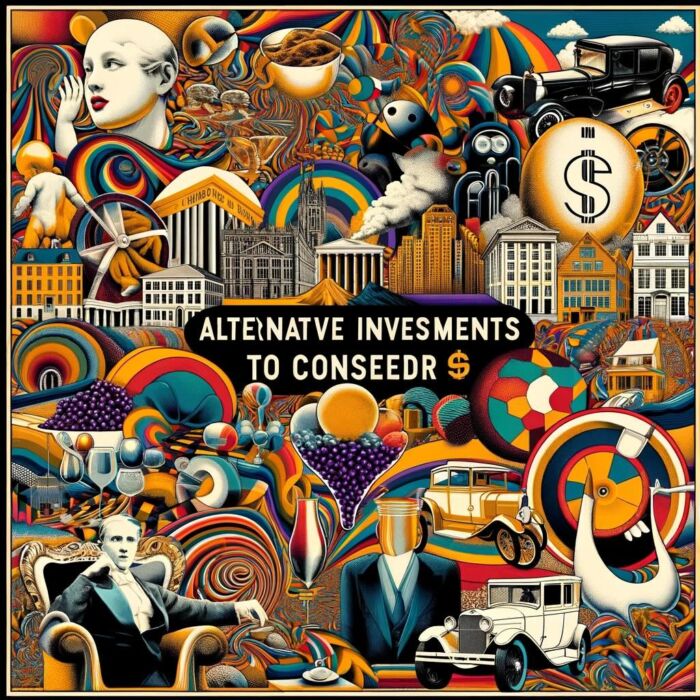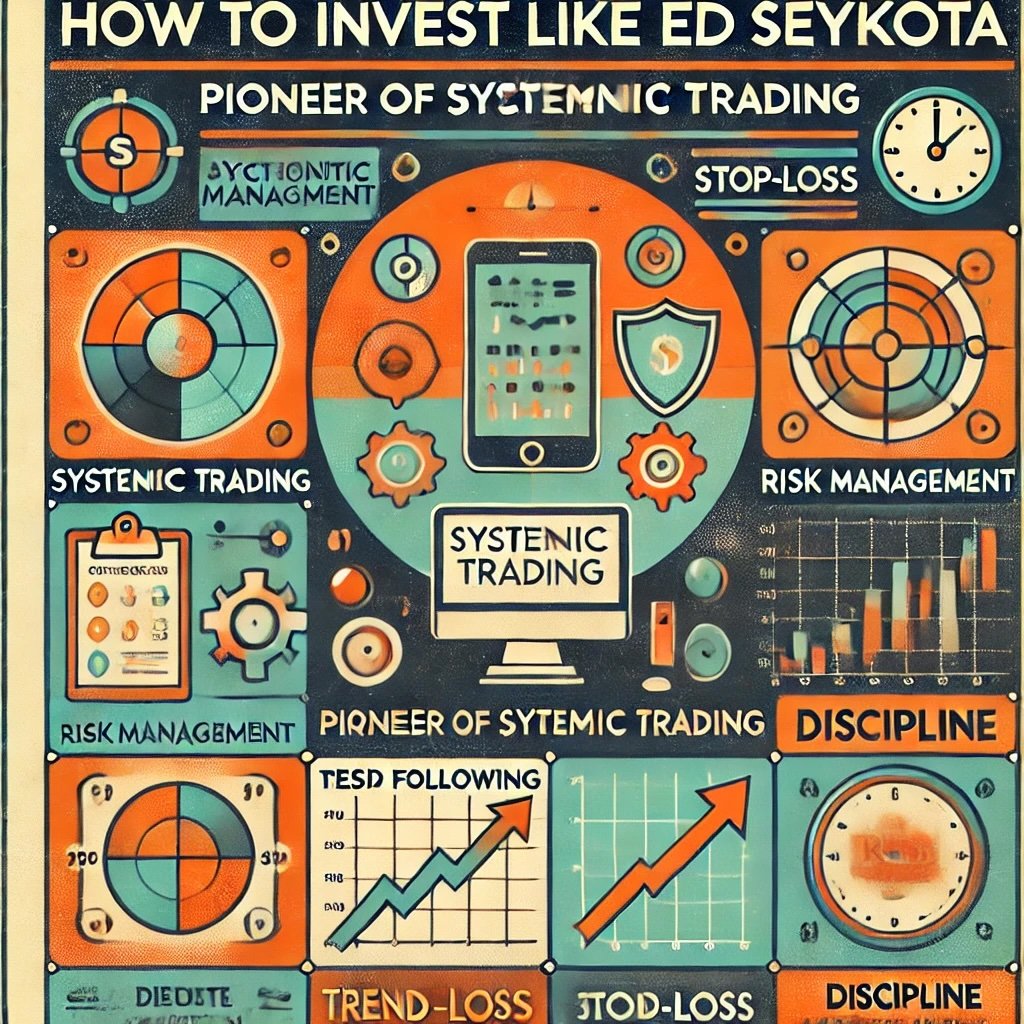Indulge me for a moment, my dear friend, as I wax lyrical about the world of alternative investments. These are not your ordinary, run-of-the-mill investments like stocks and bonds – no, no, no! They’re a thrilling and exciting way to diversify your portfolio, potentially generating higher returns and offering unique benefits such as low correlation to traditional investments.
Of course, there are risks and challenges to be aware of – limited liquidity and lack of transparency being just a couple. But for the bold investor who seeks adventure and seeks to push the boundaries of their portfolio, alternative investments can be an absolute game-changer.
source: One Minute Economics on YouTube
So, if you’re ready to explore new horizons and potentially reap significant rewards, consider diving into the world of alternative investments. It may just be the exciting, dynamic opportunity you’ve been searching for.
Here are 25 alternative investment strategies to consider:

25 Alternative Investments: Complete List

- Private Equity: This involves investing in private companies or buying ownership stakes in public companies that are not available to the general public.
- Hedge Funds: These are investment funds that use a range of strategies to generate returns, including long/short equity, merger arbitrage, and global macro strategies.
- Real Estate: This includes investing in rental properties, commercial real estate, and real estate investment trusts (REITs).
- Commodities: This includes investing in natural resources such as gold, silver, and oil.
- Global Systematic Macro: This involves investing in global markets using quantitative strategies based on economic and financial data.
- Trend Following: This involves following market trends and investing in assets that are trending upwards, while selling assets that are trending downwards.
- Managed Futures: This involves investing in futures contracts on commodities, currencies, and financial indices, and using systematic trading strategies to generate returns.
- Market Neutral: This involves investing in both long and short positions in different assets, with the aim of profiting from the relative performance of those assets rather than the absolute performance.
- Long-Short Equity: This involves taking long positions in stocks that are expected to rise in value and short positions in stocks that are expected to fall in value, with the aim of generating returns regardless of overall market performance.
- Merger Arbitrage: This involves investing in companies that are involved in mergers or acquisitions, with the aim of profiting from the price difference between the offer price and the market price.
- Multi-Factor Investing: This involves investing in stocks based on multiple factors such as value, momentum, quality, and size to achieve diversified returns.
- Options Trading: This involves using options contracts to take advantage of price movements in stocks, commodities, and other assets. Options can be used to generate income, hedge against risk, and speculate on price movements.
- Tail Risk Hedging: This involves investing in assets or strategies that can protect against extreme market events or tail risks. Examples include buying put options, investing in gold or other safe-haven assets, or using alternative strategies such as managed futures or trend following.
- Volatility Trading: This involves investing in assets or strategies that are sensitive to changes in market volatility. Examples include investing in VIX futures or options, using straddle or strangle options strategies, or using volatility arbitrage strategies.
- Art & Wine: This includes investing in paintings, sculptures, and other forms of art. This involves investing in rare and fine wines.
- Collectibles: This includes investing in items such as stamps, coins, and vintage cars.
- Cryptocurrencies: This includes investing in digital currencies such as Bitcoin, Ethereum, and Litecoin.
- Angel Investing: This involves investing in early-stage companies in exchange for an ownership stake.
- Venture Capital: This involves investing in startup companies in exchange for an ownership stake.
- Peer-to-Peer Lending: This involves lending money to individuals or small businesses through an online platform.
- Farmland: This involves investing in agricultural land and leasing it out to farmers.
- Timberland: This involves investing in forests and selling the timber for profit.
- Royalties: This includes investing in the royalties generated by intellectual property such as music, books, and patents.
- Carbon Credits: This involves investing in carbon credits and selling them to companies that are required to offset their carbon emissions.
- Distressed Debt: This involves investing in the debt of companies that are in financial distress and potentially profiting from a turnaround.

Alternative Investments: 25 Strategies In More Detail
These are just a few of the many alternative investment strategies available to investors. It is important to carefully consider the risks and potential returns of each strategy before investing. It is also a good idea to seek the advice of a financial advisor who can help you navigate the complexities of alternative investing. Let’s unpack each of these further with more detail!
source: Marketplace APM on YouTube
Private Equity
Private equity (PE) is a form of alternative investment that involves investing in companies that are not publicly traded on stock exchanges. PE firms typically buy a majority or significant minority stake in a company and actively manage it to achieve growth and improved profitability. The goal is to ultimately sell the company or take it public through an initial public offering (IPO) and generate returns for investors.
PE investments can be made in a variety of industries and sectors, ranging from healthcare to technology to real estate. They can also take various forms, such as leveraged buyouts (LBOs), growth capital investments, and venture capital.
LBOs are perhaps the most well-known form of PE investment. They involve borrowing significant amounts of debt to finance the acquisition of a company, with the goal of using the acquired company’s cash flow to pay off the debt and generate returns for investors. LBOs often target companies that are undervalued or underperforming, and can benefit from operational improvements or restructuring.
Growth capital investments, on the other hand, involve investing in companies that are already profitable and looking to expand or make acquisitions. Venture capital investments are made in early-stage companies with high growth potential, often in technology or biotech sectors.

Potential Advantages Of Private Equity
One of the main advantages of investing in PE is the potential for higher returns than traditional investments such as stocks and bonds. PE investments can generate returns through a combination of capital appreciation, dividends, and interest payments.
Another advantage of PE is the potential for diversification. PE investments are often made in a specific industry or sector, allowing investors to gain exposure to a particular segment of the economy that may not be available through publicly traded stocks.
However, investing in PE also comes with some risks. PE investments are typically illiquid, meaning that investors may not be able to sell their shares for several years or until the company is sold or goes public. This lack of liquidity can make it difficult for investors to manage their portfolios and access their capital when needed.
PE investments also often require a significant initial investment and may have high fees and expenses. Additionally, there is a higher level of risk associated with PE investments, as many of the companies involved are not publicly traded and may be more volatile than established public companies.
Private Equity can be a valuable alternative investment strategy for investors looking to diversify their portfolios and potentially generate higher returns. However, it is important to carefully consider the risks and potential rewards of PE investments before making any investment decisions. Consulting with a financial advisor and conducting thorough due diligence on any potential PE investment can help investors make informed decisions and manage their risk.
Hedge Funds
Hedge funds are a type of alternative investment that are managed by professional portfolio managers with the goal of generating high returns for their investors. These funds employ a wide range of investment strategies, often using complex financial instruments and leveraging techniques to generate returns. Hedge funds typically require a high minimum investment and are only available to accredited investors due to their high-risk nature.
Hedge funds have become increasingly popular in recent years, as investors have sought to diversify their portfolios and seek higher returns in a low-interest-rate environment. Hedge funds are known for their ability to generate returns even in volatile markets, making them an attractive option for investors seeking to hedge against market downturns.
One of the main advantages of investing in hedge funds is the potential for high returns. Hedge funds are managed by experienced professionals who are able to identify and capitalize on market inefficiencies, often using advanced quantitative analysis and sophisticated trading strategies.

Hedge Fund Portfolio Diversification Benefits
Another advantage of hedge funds is their ability to provide diversification. Hedge funds typically invest in a wide range of asset classes, including stocks, bonds, commodities, and currencies, allowing investors to gain exposure to a broad range of markets and industries.
However, investing in hedge funds also comes with a number of risks. Hedge funds are known for their high fees and expenses, which can eat into returns. Additionally, hedge funds are often highly leveraged, which can amplify losses in a down market. Hedge funds are also illiquid, meaning that investors may not be able to sell their shares for several years, which can make it difficult to access capital when needed.
Hedge funds can be a valuable alternative investment strategy for sophisticated investors seeking to diversify their portfolios and potentially generate high returns. However, it is important to carefully consider the risks and potential rewards of hedge fund investments before making any investment decisions. Consulting with a financial advisor and conducting thorough due diligence on any potential hedge fund investment can help investors make informed decisions and manage their risk.
source: Kris Krohn on YouTube
Real Estate
Real estate is a popular alternative investment that has been used by investors for many years. Real estate investments typically involve the purchase, ownership, management, rental, or sale of properties for profit. This can include everything from residential properties and commercial buildings to land and industrial properties.
One of the key benefits of investing in real estate is its potential for generating passive income through rental properties. Real estate investors can earn rental income by leasing out their properties to tenants, which can provide a steady stream of income over time. Additionally, real estate investments can provide capital appreciation over the long-term as properties increase in value.

Real Estate Income Potential
Another advantage of investing in real estate is the ability to use leverage to finance the purchase of properties. This can allow investors to buy properties with a smaller initial investment and potentially increase their returns over time. Real estate investments can also provide tax benefits, such as depreciation and deductions for property expenses.
However, investing in real estate also comes with risks. Real estate markets can be unpredictable and subject to fluctuations, which can impact the value of properties and rental income. Real estate investments also require ongoing management and maintenance, which can be time-consuming and costly.
Additionally, real estate investments are illiquid, meaning that it can be difficult to quickly sell a property and access capital when needed. This can make real estate investments less flexible than other investment options.
Overall, real estate can be a valuable alternative investment option for investors seeking to diversify their portfolios and potentially generate passive income and capital appreciation. However, it is important to carefully consider the risks and potential rewards of real estate investments before making any investment decisions. Conducting thorough due diligence on any potential real estate investment and consulting with a financial advisor can help investors make informed decisions and manage their risk.
source: PensionCraft on YouTube
Commodities
Commodities are often considered an alternative investment class that can offer diversification benefits to an investment portfolio. They are physical goods that are either consumed directly or used as inputs in the production of other goods. Common examples of commodities include agricultural products like corn and wheat, energy products like oil and gas, and precious metals like gold and silver.
One of the key reasons why investors may consider commodities as an alternative investment is because they tend to have a low correlation with traditional asset classes like stocks and bonds. This means that their returns may not move in tandem with these other investments, potentially providing a hedge against market volatility and reducing overall portfolio risk.
Another potential benefit of investing in commodities is that they may offer protection against inflation. In times of high inflation, the prices of goods and services tend to rise, but the value of commodities may also increase in response to this inflationary pressure. This can help to offset the negative impact of inflation on the value of a portfolio.

Commodities As An Inflation Hedge
There are several ways for investors to gain exposure to commodities. One option is to invest directly in physical commodities through futures contracts or exchange-traded funds (ETFs) that track commodity prices. Another option is to invest in companies that are involved in the production, processing, or distribution of commodities, such as oil companies or mining companies.
However, it’s important to note that investing in commodities comes with its own set of risks. For example, commodity prices can be highly volatile, and they may be affected by a range of factors, such as geopolitical events, weather conditions, and changes in supply and demand. Additionally, the prices of different commodities can move in different directions, meaning that an investment in one commodity may not provide the same diversification benefits as an investment in a range of commodities.
Overall, while commodities can offer diversification benefits and potential protection against inflation, investors should carefully consider the risks involved and ensure that their investment strategy aligns with their overall financial goals and risk tolerance. It’s also important to seek professional financial advice before making any investment decisions.
source: Top Trader’s Unplugged on YouTube
Global Systematic Macro (GSM)
Global systematic macro (GSM) is an investment strategy that uses computer models and quantitative analysis to trade in a range of markets, including stocks, bonds, currencies, and commodities. This approach is also known as “systematic trend-following” or “managed futures.
GSM funds aim to generate returns by identifying and capitalizing on trends in financial markets. The models used by these funds typically analyze a wide range of data, including economic indicators, market trends, and historical price data, to identify potential trading opportunities. The models then use algorithms to execute trades based on these signals.
One of the key advantages of the GSM approach is that it can provide diversification benefits to a portfolio. Because these funds trade in a range of markets, they are not tied to the performance of any single asset class. This can help to reduce overall portfolio risk and provide a potential hedge against market volatility.

GSM Adaptive Asset Potential
Another potential benefit of GSM funds is that they can be highly liquid. Because they trade in highly liquid markets, these funds can often be bought and sold quickly, providing investors with the flexibility to respond to changing market conditions.
However, it’s important to note that GSM funds also come with their own set of risks. One of the key risks is that these funds can be highly volatile. Because they trade in a range of markets, they may be affected by a wide range of factors, such as geopolitical events, economic data releases, and changes in interest rates. This can lead to large swings in returns, both positive and negative.
Additionally, the models used by GSM funds are not infallible. While they may be highly sophisticated, they are still based on historical data, which may not always be a reliable predictor of future market movements. As a result, these funds can experience periods of underperformance, which may be exacerbated by market volatility.
Overall, GSM funds can offer an alternative investment opportunity for investors looking for diversification and potential returns in a range of markets. However, investors should carefully consider the risks involved and ensure that their investment strategy aligns with their overall financial goals and risk tolerance. As with any investment, it’s also important to seek professional financial advice before making any decisions.
source: Financial Wisdom on YouTube
Trend Following
Trend following is an alternative investment strategy that involves identifying and capitalizing on trends in financial markets. It is also known as “systematic trend-following” or “momentum trading”. Trend following strategies can be used in a range of markets, including stocks, bonds, currencies, and commodities.
The basic premise of trend following is to buy assets that are increasing in value and sell assets that are decreasing in value, with the goal of capturing profits from the trend. Trend following models often use quantitative analysis and technical indicators to identify trends and to signal buy or sell orders.
One of the key benefits of trend following as an alternative investment is that it can provide diversification benefits to a portfolio. Because trend following strategies can be applied to a range of markets, they can provide exposure to different asset classes and can help to reduce overall portfolio risk.

Uncorrelated With Stocks And Bonds
Another potential benefit of trend following is that it can be adaptive to changing market conditions. Trend following models can adjust their trading signals based on changing market trends, helping to capture profits from both bullish and bearish market conditions.
However, it’s important to note that trend following strategies also come with their own set of risks. One of the key risks is that these strategies can experience periods of underperformance, particularly in range-bound or choppy markets. Additionally, trend following strategies may not capture all of the upside potential in a bull market, as they often require a significant trend to develop before they signal a buy order.
Overall, trend following can offer an alternative investment opportunity for investors looking for diversification and potential returns in a range of markets. However, investors should carefully consider the risks involved and ensure that their investment strategy aligns with their overall financial goals and risk tolerance. As with any investment, it’s also important to seek professional financial advice before making any decisions.
source: CME Group on YouTube
Managed Futures
Managed futures is an alternative investment strategy that involves trading futures contracts on behalf of investors. These contracts allow investors to gain exposure to a wide range of asset classes, including commodities, currencies, and equity indices. Managed futures are designed to provide investors with diversification benefits, downside protection, and the potential for higher returns than traditional investments.
Managed futures are typically managed by professional investment managers, who use sophisticated trading strategies and risk management techniques to generate returns. These managers may employ a range of trading strategies, including trend following, mean reversion, and countertrend trading.
One of the main benefits of managed futures is that they can provide investors with diversification benefits. By investing in a variety of futures contracts, investors can reduce their exposure to any one particular asset class or market. This can help to reduce the overall risk of the portfolio, as well as potentially increase returns.

Managed Futures Downside Bear Market Protection
Another benefit of managed futures is that they can provide downside protection. Because futures contracts are traded on margin, investors can limit their losses to the amount of their initial investment. This means that if the market moves against them, they can close out their position and limit their losses.
Finally, managed futures can potentially provide higher returns than traditional investments. Because futures contracts are highly leveraged, investors can potentially earn higher returns than they would with traditional investments. However, this also means that managed futures can be more volatile and carry a higher level of risk.
It is important to note that managed futures are not suitable for all investors. They are typically considered to be high-risk investments, and investors should be prepared to lose some or all of their investment. In addition, managed futures may be subject to high fees and expenses, which can reduce overall returns.
In conclusion, managed futures can be an attractive alternative investment for investors looking for diversification, downside protection, and the potential for higher returns. However, investors should carefully consider the risks and fees associated with managed futures before making any investment decisions.
source: Trevor Dale on YouTube
Market Neutral
Market neutral is an alternative investment strategy that aims to generate returns by exploiting market inefficiencies while minimizing exposure to market risk. This strategy involves taking both long and short positions in different assets or securities within a particular market or sector, with the goal of profiting from the price differences between them.
The idea behind market neutral investing is that by taking long and short positions in a balanced way, the investor can effectively neutralize the impact of overall market movements on their portfolio. This means that even if the market as a whole experiences a downturn, the investor’s portfolio may still be able to generate positive returns.
One of the key benefits of market neutral investing is its ability to provide diversification benefits. By taking both long and short positions in different securities or asset classes, investors can potentially reduce the overall risk of their portfolio. This can help to mitigate the impact of market volatility and minimize the risk of large losses.

Market Neutral Generating Absolute Returns
Another advantage of market neutral investing is its potential to generate consistent returns over time. Because this strategy is focused on exploiting market inefficiencies, it may be less reliant on overall market trends than other investment strategies. This means that market neutral investors may be able to generate positive returns even in challenging market conditions.
However, it is important to note that market neutral investing is not without its risks. One of the main risks of this strategy is that it relies on the investor’s ability to identify and exploit market inefficiencies. If the investor is not able to accurately identify these inefficiencies, or if market conditions change unexpectedly, the portfolio may experience significant losses.
In addition, market neutral investing may be subject to high fees and expenses, which can eat into returns. It can also be a complex strategy that requires significant knowledge and expertise to execute effectively.
In conclusion, market neutral investing can be an attractive alternative investment strategy for investors looking for diversification and the potential for consistent returns. However, investors should carefully consider the risks and complexities associated with this strategy before making any investment decisions. As with any investment, it is important to thoroughly research the strategy and seek the advice of a qualified financial professional before investing.
source: Brainy Finance on YouTube
Long-Short Equities
Long-short equity is an alternative investment strategy that involves taking both long and short positions in a portfolio of stocks. The goal of this strategy is to generate positive returns by taking advantage of both rising and falling stock prices, while also minimizing exposure to overall market risk.
The long-short equity strategy typically involves identifying undervalued stocks that are expected to outperform the market (taking long positions) and overvalued stocks that are expected to underperform (taking short positions). By taking both long and short positions, the strategy aims to capture the spread between the returns of these two groups of stocks.
One of the key benefits of long-short equity investing is its ability to provide investors with diversification benefits. By taking both long and short positions, investors can potentially reduce the overall risk of their portfolio. This can help to mitigate the impact of market volatility and minimize the risk of large losses.

Long-Short Equities Potential For Positive Returns During Any Market Condition
Another advantage of long-short equity investing is its potential to generate positive returns even in challenging market conditions. Because this strategy is focused on individual stock selection, it may be less reliant on overall market trends than other investment strategies. This means that long-short equity investors may be able to generate positive returns even in a bear market.
However, it is important to note that long-short equity investing is not without its risks. One of the main risks of this strategy is that it relies on the investor’s ability to accurately identify undervalued and overvalued stocks. If the investor is not able to do so, or if market conditions change unexpectedly, the portfolio may experience significant losses.
In addition, long-short equity investing may be subject to high fees and expenses, which can eat into returns. It can also be a complex strategy that requires significant knowledge and expertise to execute effectively.
Long-short equity investing can be an attractive alternative investment strategy for investors looking for diversification and the potential for positive returns. However, investors should carefully consider the risks and complexities associated with this strategy before making any investment decisions. As with any investment, it is important to thoroughly research the strategy and seek the advice of a qualified financial professional before investing.
source: Patrick Boyle on YouTube
Merger Arbitrage
Merger arbitrage is an alternative investment strategy that involves taking advantage of price discrepancies that may arise when one company announces plans to merge with another. The goal of this strategy is to generate returns by buying the stock of the target company and short selling the stock of the acquiring company.
The idea behind merger arbitrage is that the stock prices of both the target and acquiring companies will move in reaction to the merger announcement, but not necessarily in a predictable or efficient way. This creates opportunities for investors to profit from the price discrepancies that can occur during the merger process.
One of the key benefits of merger arbitrage investing is its potential to generate consistent returns. Because this strategy is focused on exploiting inefficiencies in the market, it may be less reliant on overall market trends than other investment strategies. This means that merger arbitrage investors may be able to generate positive returns even in challenging market conditions.

Merger Arbitrage Exploiting Market Inefficiencies
Another advantage of merger arbitrage investing is its ability to provide diversification benefits. By investing in a portfolio of merger arbitrage opportunities, investors can potentially reduce the overall risk of their portfolio. This can help to mitigate the impact of market volatility and minimize the risk of large losses.
However, it is important to note that merger arbitrage investing is not without its risks. One of the main risks of this strategy is that it relies on the successful completion of the merger. If the merger is not completed as expected, the portfolio may experience significant losses.
In addition, merger arbitrage investing may be subject to high fees and expenses, which can eat into returns. It can also be a complex strategy that requires significant knowledge and expertise to execute effectively.
In conclusion, merger arbitrage investing can be an attractive alternative investment strategy for investors looking for diversification and the potential for consistent returns. However, investors should carefully consider the risks and complexities associated with this strategy before making any investment decisions. As with any investment, it is important to thoroughly research the strategy and seek the advice of a qualified financial professional before investing.
source: Excess Returns on YouTube
Multi-Factor Investing
Multi-factor investing is an alternative investment strategy that seeks to generate returns by investing in stocks that exhibit multiple factors associated with strong performance. These factors can include characteristics such as value, momentum, quality, and size.
The goal of multi-factor investing is to create a portfolio that has exposure to a diversified set of factors that are expected to outperform the market over the long term. By investing in a portfolio of stocks that exhibit multiple factors, the strategy aims to capture the spread between the returns of these stocks and the broader market.
One of the key benefits of multi-factor investing is its ability to provide diversification benefits. By investing in a portfolio of stocks that exhibit multiple factors, investors can potentially reduce the overall risk of their portfolio. This can help to mitigate the impact of market volatility and minimize the risk of large losses.

Multi-Factor Focuses On Strong Performers
Another advantage of multi-factor investing is its potential to generate positive returns over the long term. Because this strategy is focused on factors that are associated with strong performance, it may be less reliant on overall market trends than other investment strategies. This means that multi-factor investors may be able to generate positive returns even in challenging market conditions.
However, it is important to note that multi-factor investing is not without its risks. One of the main risks of this strategy is that it relies on the investor’s ability to accurately identify the factors that are associated with strong performance. If the investor is not able to do so, or if market conditions change unexpectedly, the portfolio may experience significant losses.
In addition, multi-factor investing may be subject to high fees and expenses, which can eat into returns. It can also be a complex strategy that requires significant knowledge and expertise to execute effectively.
In conclusion, multi-factor investing can be an attractive alternative investment strategy for investors looking for diversification and the potential for positive returns over the long term. However, investors should carefully consider the risks and complexities associated with this strategy before making any investment decisions. As with any investment, it is important to thoroughly research the strategy and seek the advice of a qualified financial professional before investing.
source: Invest with Henry on YouTube
Options Trading
Options trading is an alternative investment strategy that involves buying and selling options contracts in order to generate returns. Options are financial contracts that give the buyer the right, but not the obligation, to buy or sell an underlying asset at a specific price (the strike price) on or before a specific date (the expiration date).
The goal of options trading is to generate returns by taking advantage of price movements in the underlying asset. Investors can buy call options if they expect the price of the underlying asset to increase, or buy put options if they expect the price of the underlying asset to decrease. They can also sell options in order to generate income, but this strategy carries significant risk.
One of the key benefits of options trading is its potential to generate significant returns with relatively small amounts of capital. Because options contracts are leveraged instruments, investors can potentially earn significant returns on a small investment. However, this leverage also increases the risk of losses.

Options Trading Offers Flexibility
Another advantage of options trading is its flexibility. Investors can use options to take on a range of different investment positions, from bullish to bearish, and can customize their strategies to meet their individual needs and goals.
However, it is important to note that options trading is a high-risk strategy that requires significant knowledge and expertise to execute effectively. Options trading can be complex, and investors need to have a solid understanding of the underlying asset and the options market in order to make informed decisions.
In addition, options trading can be subject to significant fees and expenses, including commissions, bid-ask spreads, and other transaction costs. These costs can significantly eat into returns and must be carefully considered before investing.
In conclusion, options trading can be an attractive alternative investment strategy for investors looking to generate significant returns with relatively small amounts of capital. However, investors should carefully consider the risks and complexities associated with this strategy before making any investment decisions. As with any investment, it is important to thoroughly research the strategy and seek the advice of a qualified financial professional before investing.
source: Logical Finance on YouTube
Tail Risk Hedging
Tail risk hedging is an investment strategy that aims to protect against extreme events, or “tail risks,” that are unlikely but potentially catastrophic. While traditional investments like stocks and bonds may provide attractive returns over the long term, they also carry a degree of risk that can be difficult to quantify. Tail risk hedging provides an alternative investment that seeks to mitigate this risk by investing in assets that are negatively correlated with the stock market.
Tail risk hedging typically involves investing in assets like put options, which provide the right to sell an asset at a predetermined price, or volatility-based products like the VIX index. These assets can help to protect against large market declines or sudden spikes in volatility, which can result in significant losses for traditional investment portfolios.
There are a number of different approaches to tail risk hedging, each with its own advantages and disadvantages. Some investors may choose to use options or other derivatives to hedge against specific risks, while others may invest in a more diversified portfolio of assets designed to provide protection across a range of different scenarios.

Protection Against Unexpected Events
One of the key benefits of tail risk hedging is that it can provide a degree of protection against unexpected events that may be difficult to predict or quantify. For example, a sudden geopolitical crisis or major natural disaster could have a significant impact on financial markets, causing sharp declines in stock prices and increased volatility. By investing in assets that are designed to provide protection against these types of events, investors can help to mitigate the potential impact on their portfolios.
Another advantage of tail risk hedging is that it can provide a source of diversification for traditional investment portfolios. By investing in assets that are negatively correlated with the stock market, investors can potentially reduce their overall portfolio risk without sacrificing returns. This can be especially important for investors who are nearing retirement or who have a low tolerance for risk.
However, it’s important to note that tail risk hedging also comes with some potential drawbacks. For one, it can be expensive, as options and other derivatives can be costly to purchase and maintain. Additionally, some investors may find it difficult to understand and implement these strategies effectively, as they can be complex and require a high degree of expertise.
In conclusion, tail risk hedging can be an attractive alternative investment for investors who are looking to protect their portfolios against extreme events and diversify their holdings. While there are some potential drawbacks to these strategies, they can be an effective way to manage risk and potentially enhance returns over the long term. As with any investment, it’s important to carefully consider the risks and rewards before deciding whether tail risk hedging is right for your portfolio.
source: Option Alpha on YouTube
Volatility Trading
Volatility trading is an alternative investment strategy that seeks to profit from changes in market volatility. Rather than investing in traditional assets like stocks and bonds, volatility traders use a variety of financial instruments to profit from changes in the level of uncertainty in the market.
Volatility can be measured in a number of ways, but one of the most common methods is to track the VIX index, which measures the expected volatility of the S&P 500 index. When the VIX is high, it indicates that investors are expecting a high degree of uncertainty in the market, while a low VIX suggests that investors are expecting relatively stable market conditions.
One of the most common ways to trade volatility is through the use of options contracts. Options give investors the right, but not the obligation, to buy or sell an underlying asset at a predetermined price. In the case of volatility trading, options are typically used to bet on changes in the VIX index.
For example, a trader might purchase a call option on the VIX with a strike price of 20. If the VIX rises above 20, the option becomes profitable, as the trader can exercise the option and purchase the VIX at a lower price than the market rate. Similarly, a trader might purchase a put option on the VIX with a strike price of 30. If the VIX falls below 30, the option becomes profitable, as the trader can exercise the option and sell the VIX at a higher price than the market rate.

Hedge Downside Risk Of Portfolio
Another common method of volatility trading is to use exchange-traded products (ETPs) that track the VIX index. These products include exchange-traded funds (ETFs) and exchange-traded notes (ETNs) that are designed to provide exposure to changes in the VIX. These products can be used to take long or short positions on the VIX, depending on the investor’s expectations for future volatility.
One of the key benefits of volatility trading is that it can provide a source of diversification for traditional investment portfolios. Because changes in market volatility are largely uncorrelated with changes in stock prices, volatility trading can provide a hedge against downside risk in a traditional portfolio.
However, it’s important to note that volatility trading can also be highly risky, as changes in volatility can be unpredictable and volatile. Additionally, many of the financial instruments used in volatility trading, such as options and ETPs, can be complex and may require a high degree of expertise to use effectively.
In conclusion, volatility trading can be an attractive alternative investment strategy for investors who are looking to diversify their portfolios and profit from changes in market volatility. While there are some potential risks associated with these strategies, they can be an effective way to manage risk and potentially enhance returns over the long term. As with any investment, it’s important to carefully consider the risks and rewards before deciding whether volatility trading is right for your portfolio.
source: RareWine on YouTube
Art & Wine
Art and wine have long been considered alternative investments that offer potential returns to investors who are willing to take on additional risks. These investments are typically considered to be more illiquid than traditional assets like stocks and bonds, but can provide diversification benefits and potential returns that are not correlated with broader market movements.
Art investment involves purchasing artworks such as paintings, sculptures, and installations, which can appreciate in value over time. The art market can be volatile, and prices can fluctuate depending on a number of factors, including the popularity of the artist, the condition of the artwork, and market demand. Some investors also choose to invest in art funds or art investment funds, which pool together funds from multiple investors to invest in a diversified portfolio of artworks.
Wine investment, on the other hand, involves purchasing high-quality wines that are expected to appreciate in value over time. Wines from renowned wineries and vintages are often considered to be the most valuable, and prices can be affected by factors such as weather conditions, wine critics’ ratings, and global demand. Some investors also choose to invest in wine funds or wine investment funds, which pool together funds from multiple investors to invest in a diversified portfolio of wines.

Fun And Diversify At The Same Time
One of the key benefits of art and wine investment is that they can provide a hedge against inflation and market volatility. Because prices for these investments are largely uncorrelated with broader market movements, they can provide diversification benefits and potentially enhance returns in a traditional investment portfolio.
However, it’s important to note that art and wine investment also come with some potential drawbacks. For one, they can be highly illiquid, as it can be difficult to find buyers for individual artworks or wines. Additionally, the value of art and wine investments can be difficult to quantify, as prices can be affected by a range of subjective factors that may not be easily measurable.
In conclusion, art and wine investment can be an attractive alternative investment for investors who are willing to take on additional risks in pursuit of potentially higher returns. While there are some potential drawbacks to these investments, they can be an effective way to diversify a portfolio and provide potential returns that are not correlated with broader market movements. As with any investment, it’s important to carefully consider the risks and rewards before deciding whether art and wine investment is right for your portfolio.
source: Reserved Investments on YouTube
Collectibles
Collectibles are another form of alternative investment that have gained popularity in recent years. This category includes a wide range of items, from stamps and coins to vintage cars and sports memorabilia. Collectibles can be an attractive investment option for those who are interested in a particular hobby or passion, as well as those looking for diversification in their investment portfolio.
The value of collectibles is largely determined by supply and demand, as well as the rarity and condition of the item. Collectors are often willing to pay a premium for rare or unique items, which can appreciate in value over time as demand increases. However, prices for collectibles can also be affected by a range of external factors, including changes in the broader economy and shifting consumer preferences.
One of the key benefits of collectibles as an investment is that they can provide diversification benefits and potentially enhance returns in a traditional investment portfolio. Because prices for collectibles are largely uncorrelated with broader market movements, they can provide a hedge against downside risk in a traditional portfolio. Additionally, collectibles can offer the potential for long-term appreciation, as well as the enjoyment and satisfaction of owning a unique or valuable item.

Potential For Long-Term Appreciation
However, it’s important to note that collectibles can also be highly illiquid and may require a significant amount of time and effort to research and manage. Additionally, the value of collectibles can be difficult to quantify, as it can be influenced by a range of subjective factors that may not be easily measurable.
When investing in collectibles, it’s important to carefully consider the risks and potential rewards before making any investments. This may include conducting thorough research on the market for a particular type of collectible, as well as the reputation and history of the sellers or auction houses involved. It’s also important to consider the costs associated with purchasing and maintaining a collection, including insurance, storage, and authentication.
In conclusion, collectibles can be an attractive alternative investment for investors who are willing to take on additional risks and who have a passion or interest in a particular type of item. While there are some potential drawbacks to these investments, they can be an effective way to diversify a portfolio and provide potential returns that are not correlated with broader market movements. As with any investment, it’s important to carefully consider the risks and rewards before deciding whether collectibles investment is right for your portfolio.
source: Lark Davis on YouTube
Cryptocurrencies
Cryptocurrencies are a digital form of currency that have gained popularity in recent years as an alternative investment option. Unlike traditional currencies, cryptocurrencies are not issued by a central bank or government, and their value is largely determined by market demand and supply.
The most well-known cryptocurrency is Bitcoin, but there are many other types of cryptocurrencies available for investment. Cryptocurrencies can be bought and sold on exchanges or through peer-to-peer transactions, and they can be stored in digital wallets that provide a high degree of security.
One of the key benefits of cryptocurrencies as an investment is that they can provide diversification benefits and potential returns that are not correlated with broader market movements. Because cryptocurrencies are largely uncorrelated with traditional assets like stocks and bonds, they can provide a hedge against downside risk in a traditional portfolio. Additionally, cryptocurrencies can offer the potential for long-term appreciation, as well as the possibility of passive income through staking or lending.

Cryptocurrencies Offer Unique Exposure
However, it’s important to note that cryptocurrencies can also be highly volatile and subject to significant price fluctuations. The market for cryptocurrencies is largely unregulated, and prices can be influenced by a range of external factors, including changes in government regulations, security breaches, and changes in the broader economy.
When investing in cryptocurrencies, it’s important to carefully consider the risks and potential rewards before making any investments. This may include conducting thorough research on the market for a particular type of cryptocurrency, as well as the reputation and history of the exchanges or platforms involved. It’s also important to consider the costs associated with purchasing and maintaining a digital wallet, including transaction fees and security measures.
In conclusion, cryptocurrencies can be an attractive alternative investment for investors who are willing to take on additional risks in pursuit of potential returns. While there are some potential drawbacks to these investments, they can be an effective way to diversify a portfolio and provide potential returns that are not correlated with broader market movements. As with any investment, it’s important to carefully consider the risks and rewards before deciding whether cryptocurrencies investment is right for your portfolio.
source: The Startup Investor on YouTube
Angel Investing
Angel investing is a form of alternative investment that involves investing in early-stage companies that have a high potential for growth. Angel investors are typically high-net-worth individuals who provide funding to these companies in exchange for equity ownership.
One of the key benefits of angel investing is the potential for high returns. Early-stage companies often have the potential for rapid growth, and successful investments can provide significant returns on investment. Additionally, angel investing can provide an opportunity to support innovation and entrepreneurship, and to potentially make a positive impact on society through the growth of new and innovative businesses.
However, it’s important to note that angel investing is a high-risk investment option. Early-stage companies often have limited track records and may not have established revenue streams, making it difficult to assess their potential for success. Additionally, these companies may face a range of external challenges, including changes in the broader economy and increased competition.

Early-Stage Potential
When investing in early-stage companies, it’s important to carefully consider the risks and potential rewards before making any investments. This may include conducting thorough research on the company’s business model, management team, and financials, as well as assessing the broader market for the company’s products or services. It’s also important to consider the costs associated with angel investing, including legal and accounting fees, and to have a clear understanding of the terms of the investment agreement.
In recent years, angel investing has become more accessible to a broader range of investors through the growth of angel investing networks and online platforms. These platforms allow investors to connect with early-stage companies and to invest smaller amounts of capital in a range of businesses, providing potential diversification benefits.
In conclusion, angel investing can be an attractive alternative investment for high-net-worth individuals who are willing to take on additional risks in pursuit of potential returns and the opportunity to support innovation and entrepreneurship. While there are some potential drawbacks to these investments, they can provide an effective way to diversify a portfolio and potentially generate significant returns. As with any investment, it’s important to carefully consider the risks and rewards before deciding whether angel investing is right for your portfolio.
source: rareliquid careers on YouTube
Venture Capital
Venture capital is a form of alternative investment that involves investing in early-stage and high-growth companies in exchange for equity ownership. Venture capital firms are typically composed of experienced investors and business experts who provide funding and support to these companies in order to help them grow and reach their full potential.
One of the key benefits of venture capital is the potential for high returns. Early-stage companies that are successful can experience rapid growth and provide significant returns on investment. Additionally, venture capital can provide an opportunity to support innovation and entrepreneurship, and to potentially make a positive impact on society through the growth of new and innovative businesses.
However, it’s important to note that venture capital is a high-risk investment option. Early-stage companies often have limited track records and may not have established revenue streams, making it difficult to assess their potential for success. Additionally, these companies may face a range of external challenges, including changes in the broader economy and increased competition.

Crowdfunding Potentail
When investing in venture capital, it’s important to carefully consider the risks and potential rewards before making any investments. This may include conducting thorough research on the company’s business model, management team, and financials, as well as assessing the broader market for the company’s products or services. It’s also important to consider the costs associated with venture capital investing, including legal and accounting fees, and to have a clear understanding of the terms of the investment agreement.
In recent years, venture capital has become more accessible to a broader range of investors through the growth of crowdfunding platforms and online investment portals. These platforms allow investors to connect with early-stage companies and to invest smaller amounts of capital in a range of businesses, providing potential diversification benefits.
In conclusion, venture capital can be an attractive alternative investment for investors who are willing to take on additional risks in pursuit of potential returns and the opportunity to support innovation and entrepreneurship. While there are some potential drawbacks to these investments, they can provide an effective way to diversify a portfolio and potentially generate significant returns. As with any investment, it’s important to carefully consider the risks and rewards before deciding whether venture capital investing is right for your portfolio.
source: One Minute Economics on YouTube
Peer-To-Peer Lending (P2P)
Peer-to-peer (P2P) lending is a form of alternative investment that allows individuals to lend money directly to borrowers through online platforms, bypassing traditional financial institutions such as banks. P2P lending platforms match borrowers and lenders based on the borrower’s creditworthiness and the lender’s investment preferences.
One of the key benefits of P2P lending is the potential for higher returns compared to traditional fixed-income investments, such as bonds. Investors can earn interest on the loans they make, typically ranging from 5% to 10%, depending on the borrower’s creditworthiness and other factors. Additionally, P2P lending can provide an opportunity to diversify a portfolio beyond traditional stocks and bonds.
However, it’s important to note that P2P lending is not without risks. Borrowers may default on their loans, resulting in a loss of principal and interest for investors. Additionally, P2P lending platforms may face regulatory challenges or other issues that could impact their operations or financial performance.

P2P Lending Offers Diversification Potential
When investing in P2P lending, it’s important to carefully consider the risks and potential rewards before making any investments. This may include researching the P2P lending platform’s track record, understanding the platform’s loan underwriting and credit risk assessment processes, and assessing the borrower’s creditworthiness and other factors that could impact their ability to repay the loan.
In recent years, P2P lending has become more accessible to a broader range of investors through the growth of online platforms. These platforms allow investors to invest smaller amounts of capital in a range of loans, providing potential diversification benefits.
In conclusion, P2P lending can be an attractive alternative investment for investors who are looking for higher returns than traditional fixed-income investments and who are willing to take on some additional risks. While there are some potential drawbacks to these investments, they can provide an effective way to diversify a portfolio and potentially generate significant returns. As with any investment, it’s important to carefully consider the risks and rewards before deciding whether P2P lending is right for your portfolio.
source: Ryan Scribner on YouTube
Farmland
Farmland is a form of alternative investment that involves investing in agricultural land with the intent of generating income or long-term capital appreciation. Farmland can be an attractive investment option due to its potential for stable income, low volatility, and potential to benefit from long-term trends in agriculture and food production.
One of the key benefits of investing in farmland is the potential for steady income from agricultural operations. Farmland owners can lease the land to farmers who grow crops or raise livestock, providing a steady stream of rental income. Additionally, farmland can potentially appreciate in value over the long term as global demand for food continues to grow.
Another benefit of investing in farmland is its potential for low volatility. Unlike other alternative investments such as commodities or cryptocurrencies, the price of farmland tends to be more stable over time, providing investors with a sense of security and stability.
However, it’s important to note that investing in farmland does come with some unique challenges and risks. These include regulatory and environmental risks, such as changes in land use regulations or environmental hazards that could impact the land’s value or productivity.

Farmland Offers Low Volatility Potential
Additionally, agricultural operations can be impacted by changes in weather patterns, disease outbreaks, or other factors that can impact crop yields and revenues.
When investing in farmland, it’s important to carefully consider the risks and potential rewards before making any investments. This may include researching the local agricultural market, assessing the quality and productivity of the land, and evaluating the potential for rental income or capital appreciation.
In recent years, investing in farmland has become more accessible to a broader range of investors through the growth of investment platforms and funds that specialize in farmland. These platforms allow investors to invest in farmland through managed portfolios or syndicated ownership structures, providing potential diversification benefits.
In conclusion, investing in farmland can be an attractive alternative investment for investors who are looking for stable income, low volatility, and potential long-term appreciation. While there are some potential drawbacks to these investments, they can provide an effective way to diversify a portfolio and potentially generate significant returns. As with any investment, it’s important to carefully consider the risks and rewards before deciding whether farmland investing is right for your portfolio.
source: Get Rich Education on YouTube
Timberland
Timberland is a form of alternative investment that involves investing in forests or other natural areas with the intent of generating income or long-term capital appreciation. Timberland can be an attractive investment option due to its potential for stable income, low volatility, and potential to benefit from long-term trends in natural resource usage.
One of the key benefits of investing in timberland is the potential for steady income from logging operations. Timberland owners can harvest the trees on the land and sell the timber, providing a steady stream of income over time. Additionally, timberland can potentially appreciate in value over the long term as global demand for timber and other forest products continues to grow.
Another benefit of investing in timberland is its potential for low volatility. Like farmland, the price of timberland tends to be more stable over time, providing investors with a sense of security and stability.

Timberland For Those Seeking Stability
However, it’s important to note that investing in timberland does come with some unique challenges and risks. These include regulatory and environmental risks, such as changes in land use regulations or environmental hazards that could impact the land’s value or productivity. Additionally, logging operations can be impacted by changes in market demand or supply, changes in the cost of harvesting, and other factors that can impact revenues.
When investing in timberland, it’s important to carefully consider the risks and potential rewards before making any investments. This may include researching the local forestry market, assessing the quality and productivity of the land, and evaluating the potential for timber sales and other revenue streams.
In recent years, investing in timberland has become more accessible to a broader range of investors through the growth of investment platforms and funds that specialize in timberland. These platforms allow investors to invest in timberland through managed portfolios or syndicated ownership structures, providing potential diversification benefits.
Investing in timberland can be an attractive alternative investment for investors who are looking for stable income, low volatility, and potential long-term appreciation. While there are some potential drawbacks to these investments, they can provide an effective way to diversify a portfolio and potentially generate significant returns. As with any investment, it’s important to carefully consider the risks and rewards before deciding whether timberland investing is right for your portfolio.
source: The Dream Green Show on YouTube
Royalties
Royalties are a form of alternative investment that involves owning the rights to receive ongoing payments from a particular asset or intellectual property. Royalties can be an attractive investment option due to their potential for stable income, low volatility, and potential for long-term appreciation.
One of the key benefits of investing in royalties is the potential for steady income from ongoing payments. Royalties can come from a variety of sources, such as music or book royalties, patent royalties, or royalties from oil and gas production. As long as the underlying asset or intellectual property is generating income, the investor will receive ongoing payments.
Another benefit of investing in royalties is its potential for low volatility. Unlike other alternative investments such as commodities or cryptocurrencies, the price of royalties tends to be more stable over time, providing investors with a sense of security and stability.

Royalties Of Low Volatility Potential
However, it’s important to note that investing in royalties does come with some unique challenges and risks. These include regulatory and legal risks, such as changes in copyright or patent laws that could impact the value of the underlying asset. Additionally, the revenue generated from royalties can be impacted by changes in market demand, competition, or technological advancements.
When investing in royalties, it’s important to carefully consider the risks and potential rewards before making any investments. This may include researching the underlying asset or intellectual property, assessing the quality and longevity of the revenue stream, and evaluating the potential for future growth or decline.
In recent years, investing in royalties has become more accessible to a broader range of investors through the growth of investment platforms and funds that specialize in royalties. These platforms allow investors to invest in royalties through managed portfolios or syndicated ownership structures, providing potential diversification benefits.
In conclusion, investing in royalties can be an attractive alternative investment for investors who are looking for stable income, low volatility, and potential long-term appreciation. While there are some potential drawbacks to these investments, they can provide an effective way to diversify a portfolio and potentially generate significant returns. As with any investment, it’s important to carefully consider the risks and rewards before deciding whether royalties investing is right for your portfolio.
source: Carbonmix on YouTube
Carbon Credits
Carbon credits are a form of alternative investment that involves owning the rights to a specific amount of carbon emissions. Carbon credits can be an attractive investment option due to their potential for generating income, their ability to contribute to sustainable development, and their potential for long-term appreciation.
One of the key benefits of investing in carbon credits is the potential for generating income through the sale of credits. Companies and governments can purchase carbon credits to offset their own carbon emissions, creating a market for carbon credits that allows investors to profit from reducing emissions.
Another benefit of investing in carbon credits is their potential to contribute to sustainable development. Many carbon credit projects involve initiatives such as reforestation, renewable energy, and energy efficiency improvements, which can have positive impacts on local communities and the environment.

Carbon Credits For Sustainable Development
However, it’s important to note that investing in carbon credits does come with some unique challenges and risks. These include regulatory and policy risks, as changes in government policies or regulations can impact the value of carbon credits. Additionally, the demand for carbon credits can be impacted by changes in the global economy or shifts in public opinion on environmental issues.
When investing in carbon credits, it’s important to carefully consider the risks and potential rewards before making any investments. This may include researching the underlying project or initiative, assessing the quality and longevity of the carbon credit revenue stream, and evaluating the potential for future growth or decline.
In recent years, investing in carbon credits has become more accessible to a broader range of investors through the growth of investment platforms and funds that specialize in carbon credits. These platforms allow investors to invest in carbon credits through managed portfolios or syndicated ownership structures, providing potential diversification benefits.
In conclusion, investing in carbon credits can be an attractive alternative investment for investors who are looking for income generation and sustainable development opportunities. While there are some potential drawbacks to these investments, they can provide an effective way to diversify a portfolio and potentially generate significant returns while also contributing to environmental sustainability. As with any investment, it’s important to carefully consider the risks and rewards before deciding whether carbon credits investing is right for your portfolio.
source: Chris Haroun on YouTube
Distressed Debt
Distressed debt is a form of alternative investment that involves purchasing the debt of companies or entities that are facing financial difficulties or undergoing restructuring. Distressed debt can be an attractive investment option due to its potential for high returns, low correlation to traditional investments, and the ability to provide capital to struggling companies.
One of the key benefits of investing in distressed debt is the potential for high returns. Distressed debt investments are often made at a significant discount to their face value, which can provide investors with the potential for significant returns if the company is able to recover and repay the debt. Additionally, distressed debt investments can provide investors with regular income through interest payments.
Another benefit of investing in distressed debt is the low correlation to traditional investments such as stocks and bonds. This can provide investors with a hedge against market volatility and a potential source of diversification for their portfolio.

Distressed Debt Low Correlations With Traditional Investments
Distressed debt investments can also provide capital to struggling companies, which can help to keep them afloat and potentially lead to a successful turnaround. This can provide a sense of satisfaction for investors who are interested in socially responsible investing.
However, it’s important to note that investing in distressed debt does come with some unique challenges and risks. These include the potential for default or bankruptcy of the underlying company, regulatory and legal risks, and the potential for significant volatility in the market.
When investing in distressed debt, it’s important to carefully consider the risks and potential rewards before making any investments. This may include researching the underlying company and its financial situation, assessing the quality and likelihood of repayment, and evaluating the potential for future growth or decline.
In recent years, investing in distressed debt has become more accessible to a broader range of investors through the growth of investment platforms and funds that specialize in distressed debt. These platforms allow investors to invest in distressed debt through managed portfolios or syndicated ownership structures, providing potential diversification benefits.
In conclusion, investing in distressed debt can be an attractive alternative investment for investors who are looking for high returns and the potential to provide capital to struggling companies. While there are some potential drawbacks to these investments, they can provide an effective way to diversify a portfolio and potentially generate significant returns. As with any investment, it’s important to carefully consider the risks and rewards before deciding whether distressed debt investing is right for your portfolio.

Alternative Investments Final Thoughts
Alternative investments can be an attractive option for investors looking to diversify their portfolios and potentially generate significant returns. These investments often have low correlation to traditional investments such as stocks and bonds, which can provide a hedge against market volatility and potentially increase overall portfolio performance.
While alternative investments can provide significant benefits, they also come with unique challenges and risks. Investors should carefully evaluate the potential rewards and risks of each investment before making any decisions. This may involve researching the underlying asset, assessing the quality and likelihood of returns, and evaluating the potential for future growth or decline.
Furthermore, investors should consider their investment goals, risk tolerance, and overall financial situation before making any investments. Alternative investments may not be suitable for all investors and should be considered as part of a well-diversified investment strategy.

Moreover, it’s important to note that many alternative investments require a significant amount of capital and may have limited liquidity, meaning that investors may not be able to easily sell their investments if they need to access their funds quickly. As such, investors should carefully consider their investment horizon and liquidity needs before making any investments.
Alternative investments can provide an effective way to diversify a portfolio and potentially generate significant returns. However, investors should carefully evaluate the risks and potential rewards of each investment before making any decisions and should consider their investment goals, risk tolerance, and overall financial situation when selecting investments.
source: Blue Sky Alternative Investments Limited on YouTube
Important Information
Comprehensive Investment Disclaimer:
All content provided on this website (including but not limited to portfolio ideas, fund analyses, investment strategies, commentary on market conditions, and discussions regarding leverage) is strictly for educational, informational, and illustrative purposes only. The information does not constitute financial, investment, tax, accounting, or legal advice. Opinions, strategies, and ideas presented herein represent personal perspectives, are based on independent research and publicly available information, and do not necessarily reflect the views or official positions of any third-party organizations, institutions, or affiliates.
Investing in financial markets inherently carries substantial risks, including but not limited to market volatility, economic uncertainties, geopolitical developments, and liquidity risks. You must be fully aware that there is always the potential for partial or total loss of your principal investment. Additionally, the use of leverage or leveraged financial products significantly increases risk exposure by amplifying both potential gains and potential losses, and thus is not appropriate or advisable for all investors. Using leverage may result in losing more than your initial invested capital, incurring margin calls, experiencing substantial interest costs, or suffering severe financial distress.
Past performance indicators, including historical data, backtesting results, and hypothetical scenarios, should never be viewed as guarantees or reliable predictions of future performance. Any examples provided are purely hypothetical and intended only for illustration purposes. Performance benchmarks, such as market indexes mentioned on this site, are theoretical and are not directly investable. While diligent efforts are made to provide accurate and current information, “Picture Perfect Portfolios” does not warrant, represent, or guarantee the accuracy, completeness, or timeliness of any information provided. Errors, inaccuracies, or outdated information may exist.
Users of this website are strongly encouraged to independently verify all information, conduct comprehensive research and due diligence, and engage with qualified financial, investment, tax, or legal professionals before making any investment or financial decisions. The responsibility for making informed investment decisions rests entirely with the individual. “Picture Perfect Portfolios” explicitly disclaims all liability for any direct, indirect, incidental, special, consequential, or other losses or damages incurred, financial or otherwise, arising out of reliance upon, or use of, any content or information presented on this website.
By accessing, reading, and utilizing the content on this website, you expressly acknowledge, understand, accept, and agree to abide by these terms and conditions. Please consult the full and detailed disclaimer available elsewhere on this website for further clarification and additional important disclosures. Read the complete disclaimer here.





